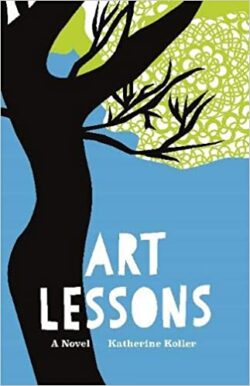Koller’s novel explores universal concepts of what it means to exist and grow, to root and transplant—as an artist, a woman, a human, a living thing. Art Lessons has the potential to take root in your heart—let it.
“Trees, for me, are like humans,” writes Cassie, the young protagonist of Katherine Koller’s debut coming-of-age novel, Art Lessons. The first-person narrative opens with Cassie as a seven-year-old budding artist and traces her inner life for the next decade, trading the colourful crayons of her childhood for charcoal sticks, blossoming and changing like the trees she sketches over time.
As the story progresses and Cassie becomes more emotionally mature, so does her voice. The earlier chapters are defined by short, simplistic observations about the happenings around her; as Cassie grows older, her thoughts reveal a heightened understanding of how art is the thread that connects people near and far, “making lines like a net on the map of the world.” Just as when a tree is rooted and transplanted, but keeps its history within the heartwood—which Darryl, an old friend, describes as “the memory of the tree”—Cassie’s art is a vessel for shared memories.
While Cassie refers to literal trees—the ones that give life to her sketchbook—it’s the family tree that nourishes her, gives her strength, and helps her grow. It’s no surprise that Cassie becomes an artist in her own right; her mother makes quilts, while Babci—named after the Polish term for grandmother, babcia—is a talented seamstress. Cassie sees Babci’s arms as branches “giving her the air she needs,” while Babci’s hands are “seed cones” that take root in her heart, filling it with “purpose, wit and compassion.”
The image of a grandmother holding her granddaughter’s hands is an endearing moment, but also echoes the intergenerational artistry that nurtured both women to become fearless creators; Babci uses her hands to sew, much like Cassie uses hers to draw. Koller’s novel takes a refreshing angle on how a young woman becomes an artist, mentored and encouraged by other women who teach her not only about art, but about life. The look that Cassie’s mother gives her children is likened to how Cassie feels when she looks at her own art. “It’s the look you give your creation,” Cassie writes.
As a book that is meant to appeal to both young adult and adult readers, Koller’s writing style, like Cassie, evolves drastically from start to finish, which some readers may find challenging to follow. That said, Koller’s novel explores universal concepts of what it means to exist and grow, to root and transplant—as an artist, a woman, a human, a living thing. Art Lessons has the potential to take root in your heart—let it.














